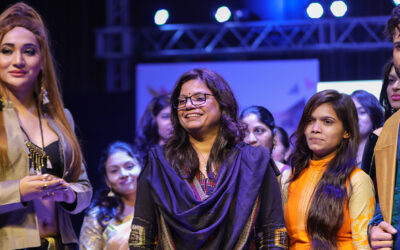Does this image bother you? Well, you’re not alone.
Over 16 years and 200 frustrating menstrual cycles later, I am finally learning to embrace periods.
Two years of dilemma of switching over to menstrual cups or biodegradable pads finally came to an end after I moved to Munger, Bihar in August 2018. There was no way I could dispose regular commercial pads here. Deplorable waste management doesn’t allow the ‘Out of sight, out of mind’ phrase to work like it often may in an urban setting. Here, you might find the waste from your bin lying around in a garbage dump at the very next Chowk. No matter how concerned I was about the bigger picture of health hazards from disposable pads and environmental challenge they pose, experiencing waste mismanagement first hand is what finally pushed me into action.
After intensive research and talking to a few friends, I bought my first menstrual cup – the SheCup, and what a blessing it has been! Since then, I’ve been pushing people I know to try one, raving about how amazing it is, but the resistance is huge. It’s amusing when women ask, “What if it’s lost inside?”. I found my own self using the disposable synthetic Stayfree again during a painful cycle, which only added further discomfort to my body and plastic to the environment. The guilt stayed and put me back on track, but let’s try to look at the larger picture and deconstruct that has kept the cup away for so long. Why are so many women bereft or choose to be bereft of its benefits?
The first menstrual cup prototypes can be traced back to the 1860’s while the first modern menstrual cups, similar to the ones we know today, were invented in 1937 by American actress Leona Chalmers. These were made from latex rubber and a shortage of the same during World War II forced the company to stop production. It was re-launched as “Tassette” in the end of 1950’s with a big advertising budget.

Tassette received a lot of criticism for its advertisements. Image courtesy: www.mum.org
The company sent thousands of samples to nurses who recommended it, however women were still reluctant to use a reusable internal device. Unable to make enough sales and having spent a fortune to market this innovation, Tassette disappeared in 1963. Menstrual cups were reintroduced in the late 1980’s with the creation of “The Keeper” made from latex rubber, a first commercial success. Eventually, in the beginning of 21st century, cups made of medical grade silicone were introduced and women with latex allergies also could now safely use menstrual cups. Their adoption, however, has been snail-paced.
Disposable pads on the other hand were made commercially available for purchase in 1888. Kimberly-Clark created Cellocotton, a synthetic cotton, to treat and bandage soldiers’ wounds in World War I. Due to its super-absorbent nature, nurses started using it during their cycle. This was the trigger to the boom of disposables industry.

Image courtesy: www.mum.org
By 1920’s, the Times of India in Bombay too was carrying ads for Kotex which did a balancing act between explaining its benefits without actually mentioning what it was for at all. A decade later, in 1936, Dr. Earle Haas marketed Tampax – the tampon with an applicator so women wouldn’t have to touch their vaginas in the process. He got the idea from a friend who used a sponge tucked into her vagina to absorb blood. Tampax found commercial success in an unprecedented increase in female workforce during the second world war. They marketed aggressively.

Though tampons earned some popularity among more forward-thinking, young and educated women, pads were still more common. Earlier, pads came with belts that women would tie around their waist to keep them in place, which was highly inconvenient. In fact, the first adhesive sanitary pad was introduced as recently as in early 1970’s.
Yet, over all these years of civilization, social stigma around “feminine hygiene”, shame attached to intimacy with one’s own vagina and unfounded notions of virginity continue to stymie women’s exploration of their own Menstrual Hygiene Management (MHM).
In India, National Family Health Survey (2015-16) report mentions that 48% of rural women use a hygienic method of menstrual protection compared to 78% urban women, with an asterisk to a footnote that says, “Locally prepared napkins, sanitary napkins and tampons are considered hygienic methods of protection”.
I have a problem with this undue importance given to commercial disposables as the only hygienic method of managing periods. Does that mean cloth is inherently unhygienic? What about menstrual cups? Despite having lived with periods since before we even fully evolved as a species, there is a gaping lacuna in the knowledge of how menstrual products work for our body and for the environment.
The Problems With Disposables
Sanitary pads and tampons, bleached to that perfect clean white, expose women to Dioxin – a range of highly toxic chemicals that are linked with increased risk of cancer. They also cause abdominal pain and hormonal imbalances, further increasing reproductive disorders and infertility, especially in urban areas with more than 70% disposables users. Tampons leave behind synthetic fibers in the vagina that can lead to irritation and bacterial infections. They are also known to cause Toxic Shock Syndrome (TSS) – an extremely rare condition caused by bacterial toxins which if caught early, is not fatal.
The super-absorbent nature of disposables, marketed as a primary benefit for “those days”, dries up the vagina, especially towards the end of the cycle when there is not much bleeding. Women end up leaving them on for long hours because they’re not full, causing rashes and irritation on which bacteria foster.
Additionally, their negative impact on the environment is irreversible. Sanitary napkins contain two more layers than a tampon – a leak-proof layer and another absorbent layer, both of which are made of plastic variants that do not biodegrade.
Methods of disposal, across urban and rural areas, include burning, burying, flushing down the toilets or dumping in water bodies or landfills. As a result dioxins find their way into soil, water and air and eventually into the food chain.
Despite the several health hazards they pose, the number of women using these products is on the rise.
Menstrual hygiene management habits are passed over from mother to daughter, along with the myths and taboos surrounding it. Clearly, huge corporations making these menstrual products over generations haven’t had the best interests of women in mind. Ever seen Whisper share a word of caution on exposure to carcinogenic chemicals in its ads or on the packs? Okay, let’s take a step back. How many sanitary product ads show menstrual blood and not the blue liquid to demonstrate the quality of absorption? They only further perpetrate the fear of staining or period odor. Further, no one talks about how to dispose used pads. These limited and mostly regressive conversations portraying periods as offensive do not allow anyone to truly understand what menstruation is and how it can be managed, let alone question existing practices.
The Alternatives
Cloth has been used since time immemorial by women to manage menses. In the last few years, NGOs and other small businesses have emerged to dispel myths and reverse the “unhygienic” tag associated with its usage. Cloth pads can be washed and reused for years if maintained with care. Some even come with a waterproof layer to prevent leakage. A cloth pad, however, is not meant to be tossed in the bin after every use. It will have to be carried back home, properly washed and dried in the sun to prevent any bacterial growth. Further, since it is layered and stitched from all sides, there are chances of the inner layers not drying up well.
In many parts of India, lakhs of women use dirty rags in the name of cloth, which cause critical health problems. Social stigma attached with periods doesn’t allow women to dry menstrual cloth in the open, which is extremely essential to prevent infections.
Neema Devi* from Bahadurpur village in Munger was sitting in class in school when she got her first period. It started with uneasiness, followed by piercing abdominal pain. She got up from her seat to use the bathroom and realized her skirt was wet and bloody. Scared and unable to understand what was happening, she ran out of school only to be found hours later by a friend, crying. “I didn’t do anything! Didn’t hurt myself, nothing bit me, I didn’t fall but I don’t know where this blood is coming from!” Her friend calmed her down saying, “…even I get this, I don’t know what it is but I get this pain too” and walked her home.
Not knowing any better herself, Neema Devi’s mother asked her to take a bath, have some warm milk and get a cloth from the room and put in her panties. “Don’t visit the temple and bathe occasionally in the pond. Use the cloth, wash it and reuse it.” She would use any cloth she could find, not wash it with soap/antiseptic and never put it out to dry under the sun.
Even today, she and her 15 year old daughter, continue to live by her mother’s suggestions.
During conversation with a SEWA Saathi she mentioned that during menses she and her daughter both suffer from problems like headaches, white discharge, pain and burning sensation on urination. Boils, rashes and acute pain are a regular affair during those 5 days. She was unable to share these problems with anybody else in her family. On prodding further, the SEWA saathi found that Neema Devi used strips from synthetic saris to manage menstruation, didn’t wash them with soap and bundled them up to dry inside the room.
She was counselled on the importance of maintaining good hygiene which she shared with her husband, who then purchased ‘sutti kapda’ for her to use.
They now also purchase pads locally and save 80 rupees every month for expense on soap, Dettol and cloth/pads.
The family is finally building a toilet for themselves.
This story is just one of the many that were reported during Menstrual Hygiene Management Project conducted by SEWA (Self-Employed Women’s Association) in Munger, Bihar. Though members were counselled on the importance of using clean cloths or pads and talking about menstruation to normalize it, we have a long way to go before the reality of various health hazards and environmental degradation from pads disposal is de-normalized. Their knowledge of options to manage menstruation stretches only as far as the social-cultural environment deems acceptable.
Organic, biodegradable pads are lately gaining popularity. With the use and throw convenience of disposables, these could be a sustainable option that don’t interfere with health or environment. However, they don’t come at an affordable price. Raw material is not easily available. The entire process of production, promotion and marketing increases the cost of small businesses that have ventured into their production.
Indian government has also launched eco-friendly Suvidha pads which were to be available across 586 Indian districts at Pradhan Mantri Bhartiya Janaushadhi centers and priced at Rs. 2.50 per pad. Their reach and impact is yet to be seen. Whether good quality is actually maintained and pads completely biodegrade under natural conditions, we’ll only know with time and usage.
Back To The Menstrual Cup
Just like cloth, it is reusable, eco-friendly and can last for years if cared for properly. It is meant to collect a woman’s period instead of absorbing it which allows you to see how much you’re bleeding and identify unusual occurrences, if any. It doesn’t dry up the vagina when bleeding is less and allows for greater freedom of movement, only requiring change every 4-6 hours. Voila! There’s nothing to dispose!
Basic levels of hygiene like washing hands before taking it out, emptying and rinsing it before re-inserting are to be maintained. One can rinse it with mild soap or hot water after every use, but it should be disinfected in boiling water before the next cycle to kill any bacterial presence.
Now, menstrual cups aren’t magic. They leak. It might take a cycle or two to adjust well and just like with other menstrual products, the leaks can be managed by changing often during heavy flow. Menstrual cups lead to tremendous savings over time. They may seem expensive, costing about INR 700-1000, and even higher for international brands but isn’t that equal to a few months of money spent on disposables. I could go on about the benefits but it’s important to mention the challenges that have held us back from embracing it.
Apart from the initial nervousness of trying something new, women are mostly grossed out about touching a menstrual cup. We haven’t learnt to deal with our own blood. Menses and menstruating women are seen as impure. In the Indian society, the idea of touching our vaginas, let alone inserting something into it, is highly offensive.
A major concern is that young girls will lose their virginity if they use the cup. People are ignorant that the hymen is not even a reliable indicator of that. Thanks to a long-standing culture of silence around sex education.
Although, high levels of hygiene should be maintained irrespective of the product used, a challenge of menstrual cup usage would be around building the habit of washing hands properly before handling the cup and disinfecting it at the right time. This could be tough, especially in rural areas where women are often working on fields or with animals. I should also mention that it is important to remove the cup every 10-12 hours and wash well to avoid even the bare minimum risk of Toxic Shock Syndrome (TSS).
On a larger note, why is it that despite being introduced around the same time, tampons took off but menstrual cups didn’t? Tampons constantly find repeat customers. Also, it’s much more difficult to advertise menstrual cups.

Tampax marketing tampon absorption. Image courtesy: www.mum.org
Popularizing sustainable menstruation in India through mass media
I don’t aim to impose the use of menstrual cup. Menstrual hygiene management is different for different women but we need to know all the options to be able to make an informed decision for our bodies and for the environment. Multiple systems need to work in parallel to reform the menstrual products industry in India. Corporations need to be held accountable for lack of transparency and unrealistic representation in commercials. The Government needs to recognize and promote progressive businesses. Researchers and innovators need to come together for studying and solving issues caused by the adverse impact of disposables.
A shift in conversations is needed.
Rigorous work is required to provide basic sanitation facilities across the country and build conscious infrastructure that is menstruation friendly, coupled with education of the masses. There are national debates on women entering temples while on their period, but not on the products that they use – clearly, re-alignment of priorities is imperative. Media has long-standing influences on people’s choices, therefore, it needs to spark the right debates. Finally, and most importantly, we need to talk more about periods to normalize them. The society needs to understand it as it is – a normal, natural, healthy function of the body.
I’m not sick, it’s not ‘that time of the month’ and there’s no Aunt Flo visiting. I’m on my period and bleeding, and I’m not ashamed.
References:




0 Comments